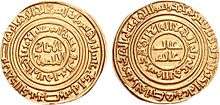Al-Amir bi-Ahkam Allah
Abu Ali al-Mansur ibn al-Musta'li (Arabic: أبو علي المنصور بن المستعلي, romanized: Abū ʿAlī al-Manṣūr ibn al-Mustaʿlī; 31 December 1096 – 7 October 1130), better known by his regnal name al-Amir bi-Ahkam Allah (Arabic: الآمر بأحكام الله, romanized: al-Āmir bi-aḥkām Allāh, lit. 'The Ruler Who Executes God's Decrees') was the tenth Fatimid Caliph, and the 20th Imam of Musta'li Isma'ili sect of Shia Islam, from 1101 to his death in 1130. Until 1121, he was a de facto puppet ruler of his uncle and father-in-law, the vizier al-Afdal Shahanshah. When the latter was murdered, possibly with al-Amir's connivance, the caliph appointed al-Ma'mun al-Bata'ihi as vizier, but took an increasing role in government, and after 1125 ruled without a vizier. His reign saw the progressive loss of all Fatimid strongholds in Palestine to the Crusaders apart from Ascalon. His assassination in 1130, leaving only his infant son al-Tayyib as heir, threw the Fatimid regime into a succession struggle during which it almost collapsed. Fatimid rule was restored with the succession of al-Amir's cousin al-Hafiz li-Din Allah in 1132, which led to the division of Musta'li Isma'ilism into the rival Hafizi and Tayyibi branches.
| al-Amir bi-Ahkam Allah | |||||
|---|---|---|---|---|---|
 Gold dinar of al-Amir, minted in Cairo in 514 AH (1119/20 CE) | |||||
| Caliph of the Fatimid Dynasty | |||||
| Predecessor | al-Musta'li | ||||
| Successor | al-Hafiz (as caliph and Hafizi imam) al-Tayyib (as Tayyibi imam) | ||||
| Born | 31 December 1096 Cairo | ||||
| Died | 7 October 1130 Cairo | ||||
| Issue | al-Tayyib | ||||
| |||||
| Father | al-Musta'li | ||||
Life
Reign under al-Afdal's tutelage
The future al-Amir was born on 31 December 1096 to the ninth Fatimid imam-caliph, al-Musta'li (r. 1094–1101).[1] In December 1101, his father died, and at the age of five he was proclaimed caliph by the all-powerful vizier, al-Afdal Shahanshah.[1] Al-Afdal was al-Amir's maternal uncle, and further strengthened the familial ties with the young caliph by marrying him to his own daughter.[2] A decree, dictated by al-Afdal, renewed his appointment as vizier with plenipotentiary powers and ensured his ascendancy over the child-caliph.[2] The first twenty years of al-Amir's reign were thus dominated by al-Afdal, who controlled government and restricted al-Amir to a few ceremonial duties.[1][3]
During this period, the main preoccupation of the Fatimid state was the conflict with the Crusaders of the Kingdom of Jerusalem. The holy war was also the main legitimization device for al-Afdal's rule and for the dynasty itself: as the historian Michael Brett writes, following the territorial losses and Nizari schism of the previous decade, that had weakened both the Fatimid state (the dawla) and the Fatimid Isma'ili mission (the daʿwa), the effort to counter the Crusaders "had given the dynasty fresh purpose".[4] Despite al-Afdal's continuous campaigns, however, most of Palestine was lost to the Crusaders, along with the coastal cities of Tartus (1102), Acre (1103), Tripoli (1109), and Sidon (1111). Egypt itself was briefly invaded by King Baldwin I of Jerusalem in 1117.[1] The Fatimids largely fell back on the coastal city of Ascalon, which developed into a major fortress and outpost (ribāṭ) of the holy war: for the next half-century it was to remain a centre for raids against the Crusader territories, and a guard of the route from Palestine into Egypt.[5] Medieval historians often blame al-Amir for these disasters, but in reality he played no role in the Fatimid government during those years.[3]
Vizierate of al-Ma'mun al-Bata'ihi
Al-Afdal's tutelage ended with his assassination at the hands of Nizari agents in December 1121. Given his own resentment at the subordinate figurehead role in which al-Afdal had relegated him, al-Amir is often suspected of having been complicit in the act.[1][3] While engaging a public display of grief for his vizier's death, al-Amir moved quickly to imprison al-Afdal's sons and confiscate al-Afdal's enormous wealth, houses, and estates, and brought the moveable items to his own palace. So great was the treasure amassed by al-Afdal that it was considered to have been larger than that of any previous king, and it took forty days to move it.[3]
As had been left out of government and was unfamiliar with its intricacies, al-Amir selected al-Afdal's long-time chief of staff, al-Ma'mun al-Bata'ihi, as vizier. Al-Ma'mun was a capable administrator, but also much weaker vis-à-vis the caliph than his old master had been: al-Amir resumed many of the old caliphal functions that al-Afdal had assumed for himself, and he henceforth had a voice in government.[3] Al-Amir is portrayed in the sources as "unusually intelligent and knowledgeable", and was said to have memorized the Quran.[3]
In the aftermath of the assassination of al-Afdal, the threat of the Nizaris, who were implacably hostile to the rule of al-Amir and his father, was a major concern of the government, in view of the widespread network of agents they had established. In December 1122 al-Amir convened a meeting of officials in Cairo in which the Nizari claims to the imamate were publicly denounced, and the legitimacy of the Musta'li claims affirmed. A proclamation to that effect, the al-Hidāya al-Āmiriyya, was issued on this occasion and has been preserved to the present day.[1][3] Al-Amir also paid attention to court the remaining pro-Fatimid Musta'li communities abroad, especially in Yemen, where he sent rich gifts to the Sulayhid queen Arwa al-Sulayhi in 1123.[3] In the same year, the Zirid emir of Ifriqiya, Abu'l-Hasan al-Hasan ibn Ali, also sent envoys to Cairo to announce his return to recognizing Fatimid suzerainty and sought Fatimid assistance in repelling a possible Norman invasion.[3]
In 1123, the Luwata Berbers invaded Egypt and reached as far as Alexandria, before they were driven back by al-Ma'mun.[1] The war against the Crusaders continued with the loss of Tyre in 1124.[1][3]
Personal rule
By 1125, al-Amir began to resent al-Ma'mun's attempts to restrict his authority, and in October 1125 had him, his brother, and his chief aides arrested. They were executed in 1128.[3] Instead of appointing a new vizier, al-Amir now ruled in person, relying on the heads of the various administrative departments for governance.[3] One of them, the Christian Abu Najah ibn Fanna, quickly rose to prominence due to his ability to provide the caliph with money through confiscations from Christians, Jews, and eventually Muslims as well. His ascendancy lasted for three years before he was denounced, arrested, and executed.[3] Having ignored the matter for so long, al-Amir's own reputation was left tarnished from the affair, as well as from his extravagance and profligacy: it is said that the palace consumed 5,000 sheep per month, and the rich gifts he made to his favourites were remarked upon.[3]
In February/March 1130, al-Amir finally had a son, who was named al-Tayyib. His birth was celebrated with public festivals, and letters were sent abroad announcing his birth as the designated successor.[3][6][7][8]
Murder and aftermath
On 7 October 1130, al-Amir was assassinated by Nizari agents. He left only a six-month-old son, Abu'l-Qasim al-Tayyib, to succeed him, with no designated regent or serving vizier.[7][9][8] Al-Amir's murder not only undid his attempts to once again concentrate power in the caliph's hands instead of over-mighty generals and ministers, but also, given the fragility of succession, endangered the very survival of the Fatimid dynasty.[9]
Al-Tayyib was quickly sidelined, and his fate is unknown;[3] it is unclear whether he died in infancy or was killed.[10][11][12] A new regime installed under the regency of his cousin Abd al-Majid which claimed to rule in the name of an unborn son by one of al-Amir's concubines.[13][14][15] This regime did not last long, as an army mutiny brought al-Afdal's last surviving son, Kutayfat, to power. Kutayfat abolished the Fatimid dynasty, but was himself assassinated by Fatimid loyalists in December 1131.[16][17][18] With no other heir available, Abd al-Majid took over as imam and caliph with the regnal name al-Hafiz li-Din Allah in January 1132, proclaiming that he had received the designation by al-Amir before he had died.[19][20][21]
Al-Hafiz' succession broke a continuous line of father-to-son succession of ten generations, something extremely rare in the Islamic world and much remarked upon by medieval authors.[3] Al-Hafiz' accession thus represented an unprecedented departure from the accepted norm, and caused yet another schism in Isma'ilism, as the Musta'li sect was divided into those who accepted al-Hafiz' succession (the "Hafizis") and those who did not, upholding instead the imamate of al-Tayyib (the "Tayyibis").[lower-alpha 1] The former were mostly concentrated in the Fatimid domains in Egypt, Nubia, and the Levant, while the latter in the Yemen, where Queen Arwa took up a leading role in forming a separate Tayyibi daʿwa.[24][25]
See also
- List of Ismaili imams
- Lists of rulers of Egypt
Footnotes
- The Tayyibis hold that al-Tayyib had been entrusted by al-Amir to a certain Ibn Madyan, and that the infant had been hidden by Ibn Madyan and his helpers when Kutayfat came to power. Ibn Madyan was killed by Kutayfat, but his brother-in-law escaped with al-Tayyib, who now went into occultation. Al-Tayyib is held to have died while still in occultation, but to have had descendants, who have provided a series of hidden imams to the present day. The public leadership of the Tayyibi community, up until the present day, was instead assumed by a succession of "absolute missionaries" (Dā'ī al-Muṭlaq).[22][23]
References
- Stern 1960, p. 440.
- Brett 2017, p. 234.
- Walker 2011.
- Brett 2017, pp. 235–237, 240–241.
- Brett 2017, pp. 240–243.
- Stern 1951, pp. 196–198.
- Daftary 2007, p. 246.
- Halm 2014, pp. 177–178.
- Brett 2017, p. 261.
- Stern 1951, p. 204.
- Daftary 2007, pp. 246, 261.
- Brett 2017, pp. 262–263.
- Stern 1951, pp. 203–204.
- Brett 2017, p. 262.
- Halm 2014, p. 179.
- Daftary 2007, p. 247.
- Brett 2017, pp. 263–265.
- Halm 2014, pp. 178–181.
- Brett 2017, p. 265.
- Halm 2014, pp. 182–183.
- Daftary 2007, pp. 247–248.
- Daftary 2007, pp. 261ff..
- Halm 2014, pp. 184, 185.
- Brett 2017, pp. 265–266.
- Daftary 2007, pp. 248, 264.
Sources
- Brett, Michael (2017). The Fatimid Empire. The Edinburgh History of the Islamic Empires. Edinburgh: Edinburgh University Press. ISBN 978-0-7486-4076-8.CS1 maint: ref=harv (link)
- Daftary, Farhad (2007). The Ismāʿı̄lı̄s: Their History and Doctrines (Second ed.). Cambridge: Cambridge University Press. ISBN 978-0-521-61636-2.
- Halm, Heinz (2014). Kalifen und Assassinen: Ägypten und der vordere Orient zur Zeit der ersten Kreuzzüge, 1074–1171 [Caliphs and Assassins: Egypt and the Near East at the Time of the First Crusades, 1074–1171] (in German). Munich: C.H. Beck. ISBN 978-3-406-66163-1.CS1 maint: ref=harv (link)
- Stern, S. M. (1951). "The Succession to the Fatimid Imam al-Āmir, the Claims of the Later Fatimids to the Imamate, and the Rise of Ṭayyibī Ismailism". Oriens. 4 (2): 193–255. doi:10.2307/1579511. JSTOR 1579511.CS1 maint: ref=harv (link)
- Stern, S. M. (1960). "al-Āmir". In Gibb, H. A. R.; Kramers, J. H.; Lévi-Provençal, E.; Schacht, J.; Lewis, B. & Pellat, Ch. (eds.). The Encyclopaedia of Islam, New Edition, Volume I: A–B. Leiden: E. J. Brill. p. 440. doi:10.1163/1573-3912_islam_SIM_0603. OCLC 495469456.
- Walker, Paul E. (2011). "al-Āmir bi-Aḥkām Allāh". In Fleet, Kate; Krämer, Gudrun; Matringe, Denis; Nawas, John; Rowson, Everett (eds.). Encyclopaedia of Islam, THREE. Brill Online. doi:10.1163/1573-3912_ei3_COM_23060. ISSN 1873-9830.
Al-Amir bi-Ahkam Allah Fatimid dynasty Born: 31 December 1096 Died: 7 October 1130 | ||
| Regnal titles | ||
|---|---|---|
| Preceded by al-Musta'li Billah |
10th Fatimid Caliph 1101–1130 |
Vacant Regency of Abd al-Majid. Temporary abolition of the Fatimid regime by Kutayfat. Title next held by al-Hafiz li-Din Allah |
| Shia Islam titles | ||
| Preceded by al-Musta'li Billah |
20th Imam of Musta'li Isma'ilism 1101–1130 |
Succeeded by al-Hafiz li-Din Allah as Imam of Hafizi Isma'ilism |
| Succeeded by at-Tayyib Abu'l-Qasim as Imam of Tayyibi Isma'ilism | ||
